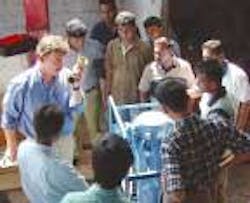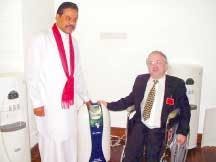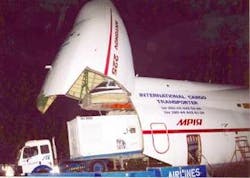Water Treatment Industry Jumps to Offer Asian Assistance after Tsunami
By Carlos David Mogollón, Managing Editor
Few could have foreseen the awesome destruction a tsunami spawned by a 9.0 magnitude earthquake the day after Christmas off the coast of Sumatra, Indonesia, would wreak on coastal areas of about 12 countries that ring the Indian Ocean.
While Indonesia, Sri Lanka, Thailand and India bore the brunt of the wall of waves Dec. 26, the tsunami's impact was felt as far as 3,000 miles away in Somalia, where 100 people died. Official death tolls quickly shot up, surpassing 220,000 at last count – but world health officials acknowledge the actual number will likely never be known. Suffice it to say, those numbers make it equivalent to over 75 Sept. 11 attacks.
Considering the remoteness of the areas affected, the immediate aftermath of the disaster's breadth caught much of the world off guard, complicated by the fact many were on vacation due to the holidays. Still, by the end of the first week of January, over $5 billion had been committed by governments and individuals who pledged donations to what will be the largest humanitarian relief effort in history, according to United Nations Secretary General Kofi Annan.
Still, the World Health Organization stressed the need to mobilize equipment and services to the region quickly to prevent any outbreaks of disease due to poor sanitation and a lack of clean drinking water. It stressed that unless the response was fast, the number of deaths due to disease could dwarf those from the immediate disaster.
Passing the Plate
Laudably to all, many companies and organizations met the UN and WHO challenge and stepped forward to play an additional role beyond raising money to help ensure clean water for the 2-5 million people displaced by the initial disaster and flooding that followed, contaminating well water supplies with seawater and damaging – if not wiping out entirely – infrastructure for sanitation and other services.
Among the leaders in these efforts have been conglomerates General Electric, Siemens, Bayer and ITT Industries, as well as corporations such as Zenon Environmental, Pall Corp. and Arch Chemical. Other just as significant efforts also have come from Flowserve and Danaher – through its Trojan Technologies and Hach units – in addition to smaller companies: AirWater Corp., WaterChef, WaterHealth International, Pure-O-Tech and Wisconsin Pharmacal.
Like many, some made just financial contributions, which flooded the American Red Cross, UNICEF and other public health and related non-governmental organizations around the world. A number also have donated equipment, partnering with small and large relief organizations or, if they had them, contacts in the region. Larger corporations have been able to mobilize staff at subsidiaries or offices they had near the affected areas.
Bayer Corp, for instance, donated over $13 million in funds and equipment through various subsidaries, business units and individual employees. It recently spunoff Lanxess, which included Sybron Chemicals- a maker of ion exchange resins.
Mobilizing Resources
And General Electric announced Jan. 7 it donated through Scotts Valley, Calif.-based Assist International (www.assistinternational.org) a GE Mobile Water unit that can generate up to 432,000 gpd of potable water for relief efforts in Banda Aceh, Indonesia – where 60% of the city nearest the earthquake was destroyed. Later, it said a second tractor trailer-mounted unit from GE Water & Process Technologies was sent as well. The 75-ton shipment from a GE facility in Dubai, U.A.E., was airlifted on the world's largest aircraft, the Antonov An-225 – originally built for the Soviet space program.
Designed to purify up to 600 gpm, the two mobile water units – each of which includes filtration and reverse osmosis systems – can provide potable water for up to 220,000 people daily. In addition, GE Energy donated a mobile fleet of generators and engineers to power the mobile units. More than 50 GE scientists, engineers and project managers have participated in the effort.
"Right now, GE's project engineers are on the ground in South Asia ...(and) will help support and oversee that the victims have access to fresh water from now until the government and its resources can sustain operations independently," said Bryan Rishforth, general manager of GE's Water & Process Technologies.
Likewise, GE also donated three water purification systems to the Thai Red Cross. Together the two are working to deliver 66,000 gpd of potable water to aid an estimated 5,000 people in the three largest Thai Red Cross shelter centers located in the Pang Nga, Phuket and Kao Lak regions.
Overall, GE said it's contributed more than $10 million toward the relief effort, including $2.4 million in employee donations as of Jan. 6 that are being matched by the GE Foundation. Separately, the foundation pledged $1 million to the Red Cross and $100,000 to UNICEF toward disaster relief efforts. Working across 16 time zones, GE Infrastructure's offices in the United States, United Arab Emirates, Singapore, Thailand and India have been coordinating GE's fresh water relief efforts.
Fast-track Delivery
Siemens made its key donation through its USFilter subsidiary's Australian unit. Memcor group, working with Siemens Thailand office and Loxley Public Co., its distributor in Thailand, plans to contribute seven treatment units, which combine its membrane and disinfection technology. Each unit is capable of converting raw water into 26,400 gpd – 184,800 total gpd – of water fit for drinking and other potable uses.
USFilter was building six of the units on a fast-track schedule at its Memcor plant in Windsor, Australia. According to plant manager Bruce Biltoft all of the units were to be shipped from Jan. 25-Feb. 8. The seventh unit is already located in Thailand where it was being prepared as a demonstration unit prior to the tsunami. As soon as it is tested and commissioned, it was to be relocated to the disaster area.
Once the water treatment units are in Thailand, Siemens and Loxley will fit them out with ancillary components – such as covers or piping – that may be required depending on where the units will be deployed. At this moment, the companies are working in parallel to have all necessary components available so that final assembly, installation, and operation of the units can occur as rapidly as possible, Biltoft said.
As of Jan. 11, Siemens also had provided over $1.3 million to relief efforts, while its employees contributed $444,496.43 through Siemens Caring Hands in Germany (with more than 3,350 donors participating). In Thailand, Siemens employees also donated over 1 million baht [US$25,967.14].
Quick Response
Meanwhile, working through Oxfam (www.oxfamamerica.org) and the International Federation of Red Cross and Red Crescent Societies (www.ifrc.org), ITT Industries coordinated the various companies under its Fluid Technology business unit to mobilize and get volunteers to the scene quickly. Among them was ITT China president Mark Steele who posted a missive to the company website on Jan. 16 when their team got the first water treatment systems up and running in Sri Lanka.
"The outpouring of relief aid and support from the world has been tremendous. As part of this, the ITT team here in Sri Lanka has witnessed firsthand the smiles and gratitude of the Sri Lankan people. So, in our small way, we in ITT Industries have made a difference – a difference for the people of Sri Lanka, and a difference in this world as it recovers from the biggest disaster in living memory," Steele said.
In all, ITT shipped over 80 portable ST1 water filtration systems and 10 RO systems to the disaster area. Combined, they're capable of treating water for over 800,000 people a day. The units are diesel powered – enabling them to operate in many areas without electricity – and simple to operate and maintain, as well as providing the level of treatment necessary to combat waterborne diseases such as cholera and giardiasis. It also shipped 200 gas-powered chlorinators suitable for emergency use.
In addition, ITT made a donation of $500,000 to the general relief effort.
Corporate donors
Canada's Zenon Environmental teamed up with Eureka Forbes, a leading water company in India, and the Christian relief organization World Vision (www.worldvision.org) to send an initial shipment of 54 Homespring water filtration units for South Asia tsunami disaster recovery efforts. The systems, which were bound for Chennai, India, and Sri Lanka, will provide safe drinking water for up to 350,000 people. Incorporating Zenon's ZeeWeed ultrafiltration membranes, each unit can produce up to 7,000 gpd of potable water. The Oakville, Ontario, company's larger water purification systems, which the Canadian Army has used for years, also are being deployed via Canada's Disaster Assistance Relief Team (DART).
Pall Corp., of East Hills, N.Y., donated an RO water filtration system capable of providing safe drinking water to 60,000 people a day for the tsunami relief efforts. It replaces a water treatment system that was destroyed in the Aceh province of Sumatra, Indonesia. The system, which uses Pall's Disc Tube Modules, converts very poor quality water into potable water in a single step without pretreatment. The company also provided technical training to Technisches Hilfswerk, the German governmental disaster relief organization, which will operate the $75,000 mobile system made available from Pall's operations in Hamburg, Germany.
Arch Chemicals is working with the global Water Relief Network to provide its HTH chlorine-based water sanitizing products to help the survivors of the tsunami. These chemicals are used to sanitize drinking water as well as food-preparation surfaces and equipment. The network is a partnership of the global chlorine industry, the American Red Cross and other international relief agencies. Arch's granular calcium hypochlorite product also is the sanitizing agent in millions of drinking water treatment sachets that a major, global consumer products company is donating to aid the disaster relief effort. And Arch encouraged employees to donate to any nonprofit disaster-relief agencies aiding the tsunami relief effort by promising to match, up to $10,000, through a corporate donation to the American Red Cross.
Dallas-based Flowserve Corp. on behalf of its 14,000 employees around the world, pledged up to $150,000 to the Red Cross for relief efforts in Southeast Asia. Of that, $50,000 was a corporate donation and the company promised to match up to $50,000 raised by its employees. Operating in 56 countries, it produces engineered and industrial pumps, seals and valves as well as offering a range of related flow management services.
Trojan Technologies, of London, Ontario, Canada, also committed to sending product to the region – although because of the nature of its ultraviolet disinfection equipment, it may wait until later when more basic infrastructure is in place and it's more useful. Trojan spokeswoman Martha Nelsen said, "We've been in touch with a number of nonprofit organizations and don't want to send equipment there just to have it sit and not get used or just be in the way. But we've been very active working behind the scenes to provide some support." She noted Trojan's corporate parent, Danaher also has contributed to the Red Cross and committed other of its companies such as water testing and analytical instrumentation specialist Hach Company, of Loveland, Colo., to provide additional equipment toward the relief effort.
Small is Big
Smaller firms WaterChef Inc., of Glen Head, N.Y., and Air Water Corp., of Miami, were donating equipment as well – respectively, two PureSafe Water Stations that treat up to 15,000 gpd and 20 AirWater Machines that extract water from humidity in the air. The AirWater units, producing 5,000 liters a day each, were destined for Sri Lanka, Thailand and India. In addition, the company announced an order Jan. 19 for 270 units to be sent to Sri Lanka. And Air Water president Michael J. Zwebner also pledged $25,000 to general relief efforts. The WaterChef units were purchased by an Indian family living in New York for relief efforts. Later, individual WaterChef shareholders also purchased an additional three water station units, with a market value of $230,000, for tsunami disaster relief efforts.
WaterHealth International, of Lake Forest, Calif., plans to place 50 emergency relief systems in Sri Lanka through a cooperative effort between the International Finance Corp., the Sri Lanka Red Cross, and donations received via Global Giving (www.globalgiving.com). The IFC, a member of the World Bank, is funding up to $250,000 in matching funds to be raised by the Ceylon Chamber of Commerce through Global Giving. The UV WaterWorks disinfection units will provide safe drinking water to meet the short term needs of up to 100,000 displaced Sri Lankans. WHI also is placing three community water systems for tsunami relief in Tamil, Nadu, India. These systems have been purchased by Applied Materials and will be situated in shelters and temporary camps to meet the immediate needs of nearly 20,000 displaced people.
Escondido, Calif., based Pure-O-Tech Inc. – which manufactures a portable water treatment system called the Enviro-Wash – happened to have a unit at the Anna University in Chennai, India, to demonstrate its effectiveness, when the tsunami struck. The ozone disinfection unit can provide the daily potable water needs for about 5,000 people. Company R&D vice president Ben St. Onge was being sent, thanks to the contribution of the California law firm of Luce Forward Hamilton & Scripps, to find areas where additional systems can be set up. Law firm employees raised $5,000, which was matched by the firm, toward that effort.
And Wisconsin Pharmacal, a small company in Jackson, Wis., and one of the world's leading producers of iodine-based water purification tablets, donated more than 10,000 bottles of EPA-approved Potable Aqua water purification tablets to relief organizations aiding victims affected by the Asian earthquake and tsunami disaster. It stated it also would match any tablets purchased specifically for donation to tsunami relief efforts.
Long-Term Goals
Lastly, both the American Water Works Association and Water Environment Federation were encouraging water industry professionals to make donations to Water For People (www.waterforpeople.org), an international nonprofit organization that focuses on long-term development programs to improve water quality in impoverished areas around the world. The WEF Board of Trustees also approved a $25,000 contribution Jan. 18 to WFP to support rebuilding of water and sanitation infrastructure in affected areas.
Emergency Relief OrganizationsIf you would care to assist in the humanitarian response to the tsunami disaster, feel free to contact the following:
— UNICEF: www.unicefusa.org or call 800-486-4233
— American Red Cross: www.redcross.org or 800-435-7669
— Americares: www.americares.org or call AmeriCares directly at 800-486-4357
— CARE: www.care.org or 800-422-7385
— Save the Children: www.savethechildren.org or 800-728-3843
— Doctors Without Borders: www.doctorswithoutborders.org or 888-392-0392
— The Network for Good: www.networkforgood.org
Donations can be specified for "South Asia Tsunami Relief Effort," but remember that a number of other areas of the world also may continue to need assistance as resources are redirected to this region. In that case, "Where the Need is Greatest" might be appropriate.





